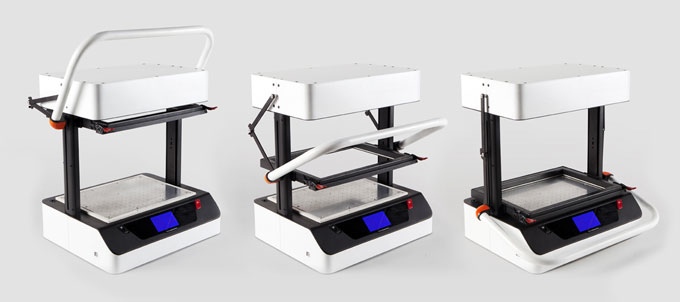Vacuum formers are useful tools to have around the shop and also an incredibly simple technology. All you need is a plastic sheet, a heater of some kind, a table with a bunch of holes in it, and a vacuum. The simplicity and usefulness of a vacuum former mean they’re perfect for a homebrew build. That said, we haven’t seen many DIY vacuum formers around the Interwebs. Now, there’s a Kickstarter that brings vacuum forming to the desktop. If nothing else, it’s an inspiration to build your own vacuum forming machine.
The Vaquform is pretty much what you would expect from a desktop vacuum forming machine. A 9 x 12 inch forming area is equipped with ceramic heaters to soften the plastic sheet, and interestingly, an infrared probe (think a non-contact digital thermometer) to ensure you’re pulling molds when the plastic is ready, not before.
You can’t push a Kickstarter without some new and novel technology, and the highlight of this product pitch is the Vaquform hybrid system vacuum pump. This vacuum pump, “combines high airflow and high vacuum” and looks like someone slapped a brushless motor on a turbo.
This is a Kickstarter campaign, and so far it appears Vaquform, the company behind this vacuum former, appears to only have prototypes. There’s a big difference between building one of something and building a hundred. As with all Kickstarter campaigns, ‘caveat emptor’ doesn’t apply because ēmptor means ‘buyer’. If you contribute to this Kickstarter campaign, you are not buying anything.
Even though this is a Kickstarter campaign, it is an interesting tool to have around the workshop. Of course, there’s not much to a vacuum former, and we’d be very interested in seeing what kind of vacuum former builds the Hackaday community has already made. Send those in on the tip line.
















Looks to me like they just have 2 pumps. An impeller pump for roughing, and something positive displacement to draw a little harder. That’s kinda SOP if you need a deeper vacuum than you can get with a high flow low vac pump, isn’t it?
Yes, I would say they describe it like that. Although for me it looks much more like something where somebody slapped a brushed motor on a turbo. :-) Which is completely OK for that application.
I came here to trash Kickstarter, but I think you’ve got that pretty well covered.
Not that anyone would ever need to trash Kickstarter, it’s already pretty crappy on it’s own accord. The vast majority of the projects on there are either scams or just pure rubbish that has no real use beyond immediate consumption.
That is what happens when you let a group of people turn a company into a crusader arm of a political agenda.
Lol just came here to say thanks for the title, it gave me a chuckle. It carries two meanings and it seems that it applies on both cases.
I Hate vacuform packaging . Abolish it now
Thanks
vacuum forming has its uses, I’ve done a pinball ramp that is not in production any more and it worked out great. However the build is the easy part, learning how long to leave any particular type of plastic heated up is a bit of an art form.
I like the idea of using an IR surface thermometer. Touching the surface and checking to see how “bouncy” the plastic is with your fingers never seems like a good idea.
We did this in junior high ’65. I came across a inflatable boat hand pump double acting, hook up one way to blow up, the other way really sucks. I unclogged a troublesome drain that a snake could not get into. You’d only need high vac for a little while and a blower or air jet would hasten setup.
Well, being the most force you could hope for is only 14.7 psi………why not pressurizer the plastic side to positive pressure? I don’t think I’ve seen that on a home machine yet. Or is there a reason why it’s not done?
14 psi is normally more than enough. Lots of designs use a vacuum cleaner which probably only gets down to ~5psi below atmospheric.
Most issues w/ webbing & poor detail can be remedied by going a few degrees hotter, shaping your bucks better, drilling holes in the buck, donning some leather gloves to smooth it out, or using a different thickness of plastic.
There’s no reason why a hobbyist ‘former couldn’t have positive pressure but it’s one more seal to leak and you need expensive quick exhaust valves to dump the air in. Unless you’re doing fully automated stuff it’s generally not worth the effort.
Every vacuum form tutorial I’ve ever seen pretty much ends with “here’s your Stormtrooper armor!”
Nice to see the Kickstarter poke fun at that with the Vader helmet.
We built a Protoform machine at i3Detroit, and it’s served us really well. The plans are well-thought-out and assembly is straightforward, albeit tedious at times, like drilling all the holes in the platen. It’s a pretty big machine and we’ve never been left wanting for more.
Our build wasn’t particularly well documented, but there are numerous videos of the Proto-Form in operation, from us and others. It’s an appropriate machine for a good-sized *kerspace, probably overkill for an individual hobbyist unless they’re a serious prop-maker.
Nostalgia: http://www.ebay.com/itm/Vintage-1962-Working-Mattel-VAC-U-FORM-with-box-and-extras-/142259014326